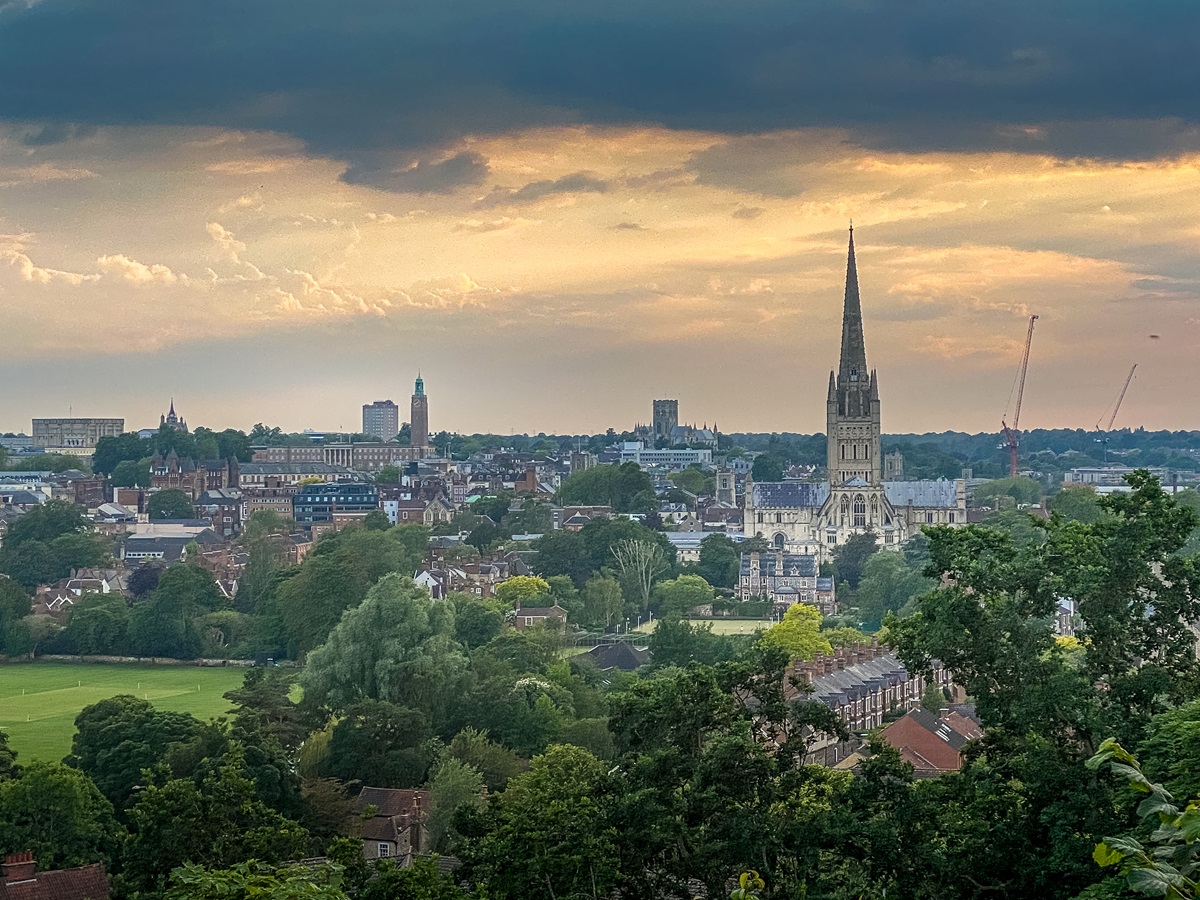Norwich is a city that will surprise you. It has quite an interesting and sometimes unexpected history. We’ve rounded up some fun facts about Norwich to provide a little background ahead of your visit and to help you win that pub quiz.
Be sure to sign up for our email newsletter here, so we can send you more interesting information about Norwich and the rest of Norfolk.
Note: This post contains affiliate links. As an Amazon Associate, we earn from qualifying purchases. Please see disclosure for more information.
Interesting Facts about Norwich
This list doesn’t just include cool and quirky trivia about Norwich, we also included a little background information as well. Some of these facts may be a bit more obscure than others.
#1 Norwich calls itself “a fine city.”
It’s a bit of a running joke, as the slogan has been around for a while.
Many attribute the phrase to George Borrow, who grew up in Norwich. He wrote in his 1851 semi-autobiographical novel Lavengro:
‘A fine old city, truly, is that, view it from whatever side you will; but it shows best from the east, where the ground, bold and elevated, overlooks the fair and fertile valley in which it stands. Gazing from those heights, the eye beholds a scene which cannot fail to awaken, even in the least sensitive bosom, feelings of pleasure and admiration. At the foot of the heights flows a narrow and deep river, with an antique bridge communicating with a long and narrow suburb, flanked on either side by rich meadows of the brightest green, beyond which spreads the city; the fine old city, perhaps the most curious specimen at present extant of the genuine English town.’
George Borrow
He may not have been the first to use the phrase in print though. William Cobbett’s 1820s novel Rural Rides contains this sentence:
‘Norwich is a very fine city, and the castle, which stands in the middle of it, on a hill, is truly majestic.’
William Cobbett
Maybe Cobbett doesn’t get the credit because he is from Surrey?!
#2 During much of medieval times, Norwich was England’s second city.
Although Norwich may be small by today’s standards, it was once the second largest city in Britain (behind London). It was a centre of trade and prospered from the lucrative wool business. The city’s fortunes declined in the 18th century as the Industrial Revolution spurred the expansion of new towns and industry in the north of England.
#3 Norwich Market is the largest open air market in the country (and one of the oldest).
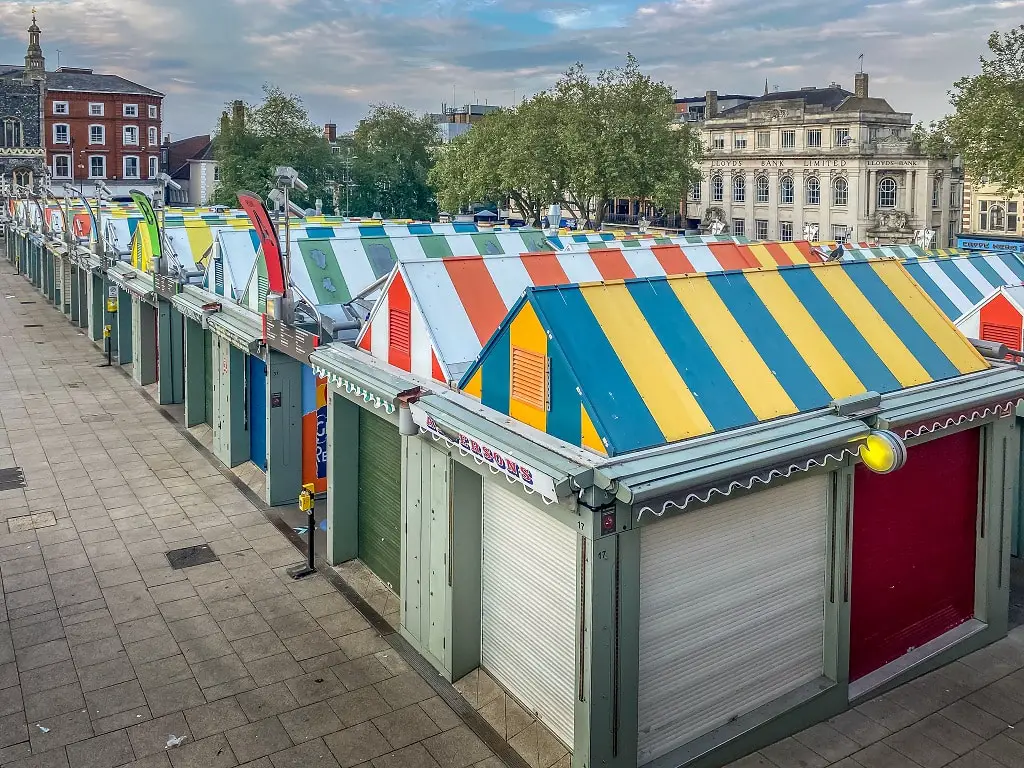
You can’t miss Norwich Market in the city centre with its 189 colourful stalls offering a wide variety of goods. It was founded towards the end of the 11th century to supply Norman merchants and settlers moving to the area, replacing an earlier market a short distance away. The market has been in operation on the present site for over 900 years.
#4 Norwich is the only English city to be excommunicated by the Pope.
The people of Norwich were at odds with the cathedral monks for years, mostly about rights and boundaries. Then in 1272, things got violent and one church servant shot a man with a crossbow. The authorities had two others arrested.
A few weeks after the riot, the pope delivered his excommunication and the violence continued. Edward I had to settle the conflict, forcing the city to pay the church £2,000 and build the Ethelbert Gate to the Cathedral.
#5 Norwich Cathedral has the second tallest spire and second largest cloisters in England.
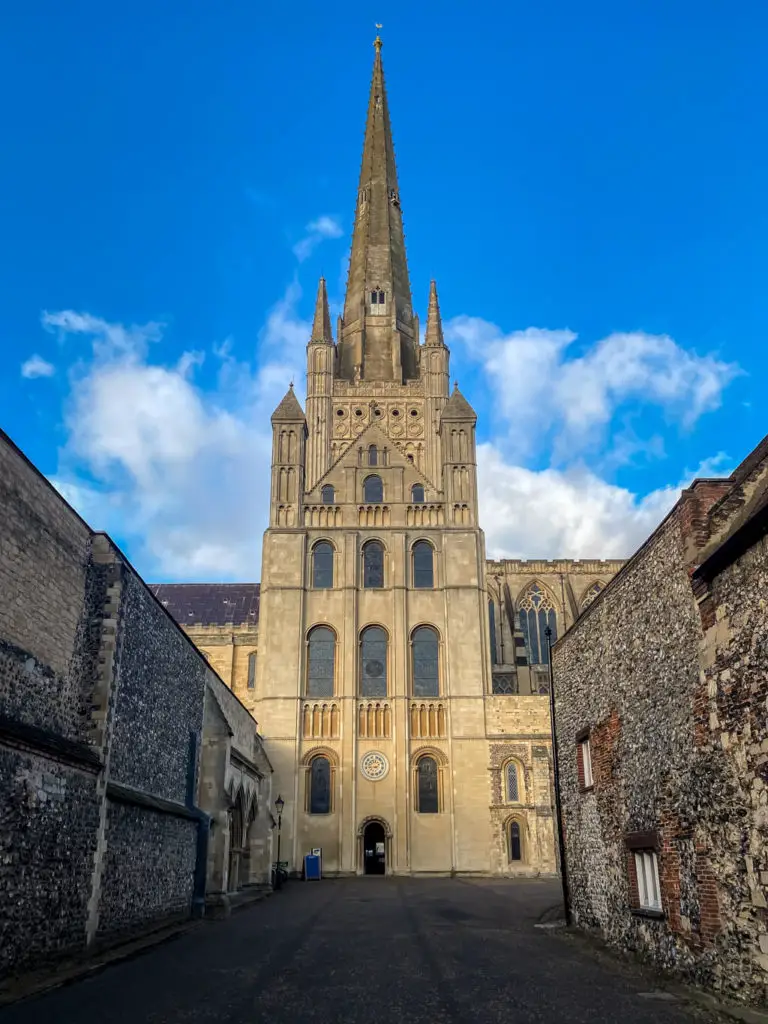
Norwich Cathedral is one of the places you must see when you visit Norwich. It’s one of the lesser known cathedrals in the country but has several claims to fame including:
- The second tallest spine and second largest cloisters in England, only exceeded by Salisbury Cathedral.
- The cathedral close is one of the largest in Europe and has more people living within it than any other close.
- It has the most medieval roof bosses of any cathedral in the Christian world.
- It was the only Cathedral that was part of Dippy’s Tour around the country.
#6 During the Middle Ages there were 58 churches within the city walls.
It’s been said that Norwich had a church for every Sunday as there were 58 individual parish churches within the city walls during the medieval period. Of those, 31 have survived but only a few are still used as active places of worship. Some have been turned into antique shops and cafes.
The largest parish church in Norwich is St Peter Mancroft which is located by the Forum. It is known for its medieval stained glass, its collection of medieval and renaissance treasures like the beautiful Mancroft resurrection tapestry from 1573, and its importance as a pioneering tower in the uniquely English art of change-ringing of church bells.
#7 In the 19th century, Norwich boasted that it had one pub for every day of the year.
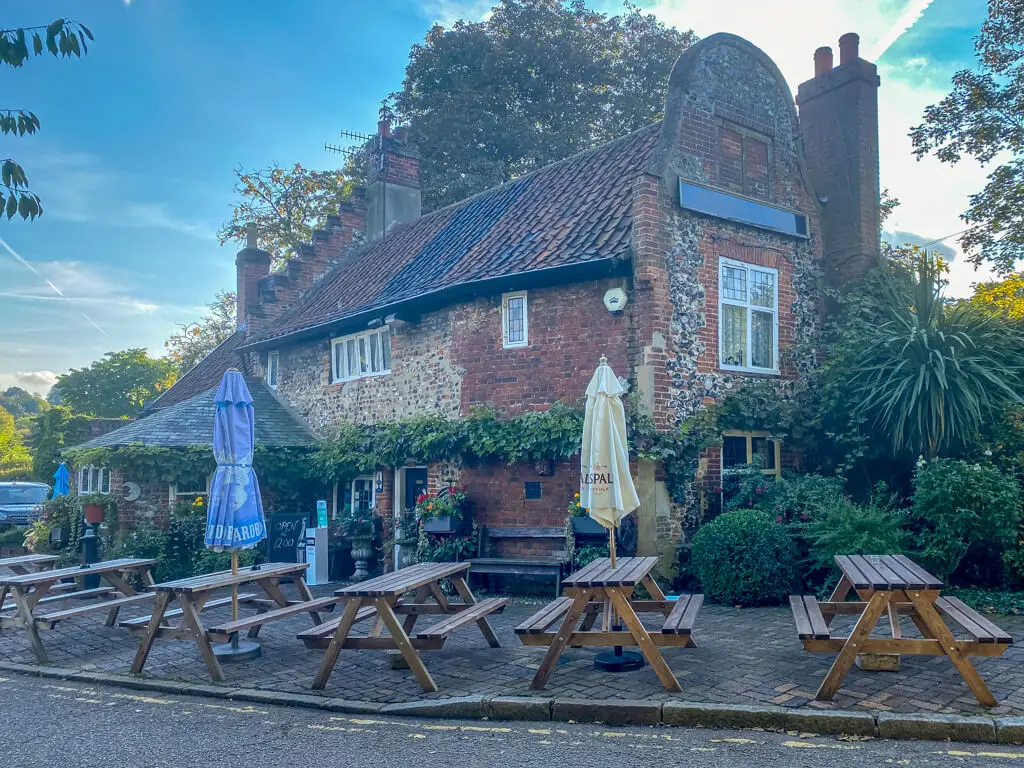
The Adam and Eve was the first pub in Norwich, dating back to the 13th century. The number of pubs in Norwich rose to as many as 600 in 1884 which would be almost two for every day of the year.
Then the 1904 Licensing Act, Second World War and widespread slum clearances of the 60s led to a significant decline. Today there are only around 130 that are still open. King Street was particularly hard hit as it went from having 58 pubs to only one, which is now called The Last Pub Standing.
RELATED: Riverside Pubs in Norwich
#8 The first book written by a woman in English was written in Norwich.
Julian of Norwich (1342-1416) spent much of her life in a cell as an anchoress in St Julian’s Church just off King Street, where she wrote Revelations of Divine Love. The book is an account of her visions and is still in print today.
The Christian mystic was the first woman to be write a book in English. The bridge across the Wensum River closest to the church is called the Lady Julian Bridge after her.
#9 Norwich was named the 6th UNESCO City of Literature in 2012.
Norwich made a strong case to become a UNESCO City of Literature:
- It was the first UK City of Refuge for persecuted writers.
- The Norfolk and Norwich Millenium library located inside the Forum is one of the busiest and most used in the country.
- The University of East Anglia hosts two international literary festivals a year and has a creative writing course centre that is one of the most famous in the world.
- Several notable writers have worked, studied and taught in the city including Julian of Norwich, Kazuo Ishiguro, Angela Carter, Lorna Sage, Rose Tremain, and Ali Smith.
- The city’s new nickname is the “City of Stories”
Norwich is the sixth city to be given the title, after Edinburgh, Melbourne, Iowa City, Dublin, and Reykjavik. As of 2021, there were 39 Cities of Literature, across 28 countries and six continents.
The National Centre of Writing is now housed in the historic Dragon Hall on King Street.
#10 ‘On The Ball City’, Norwich City Football Club’s song, is the oldest UK football song that is still used today
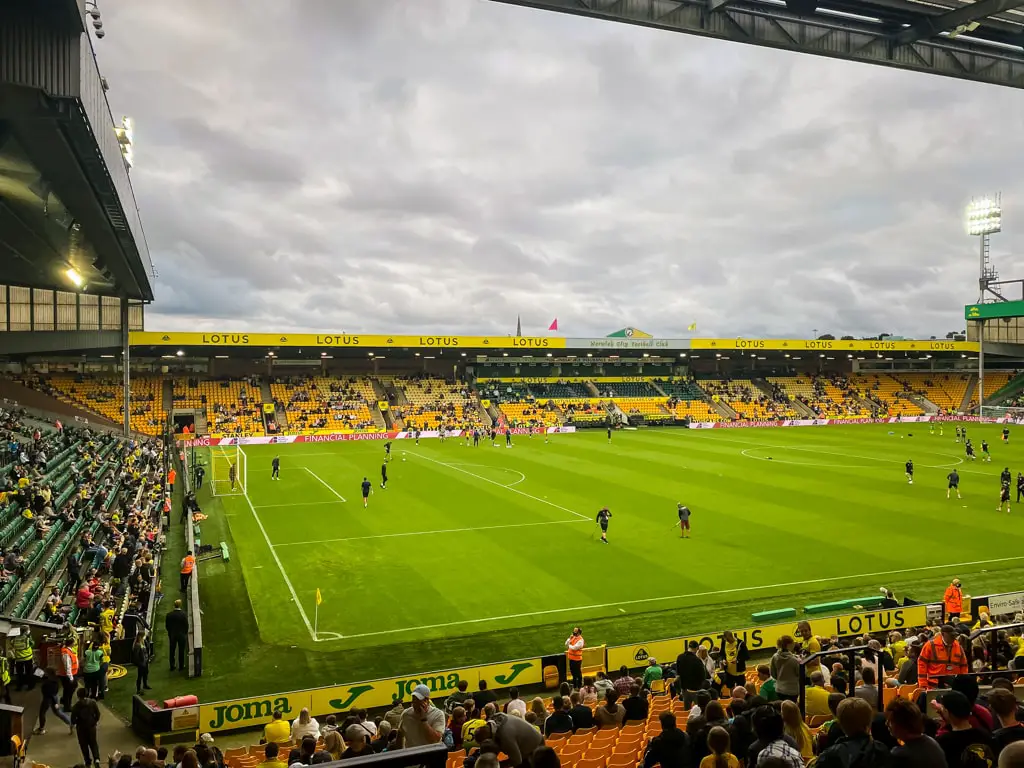
The song is in fact older than Norwich City Football Club itself as it is believed to be written for Norwich Teachers or Caley’s FC in the 1890. It was also used by clubs such as Swifians and Norwich CEYMS before being adopted by Norwich City in 1902.
Albert T Smith, who became a director of Norwich City when the club was founded in 1902, is credited with writing “On the Ball City’ (OTBC for short). The song is still sung by supporters before matches at Carrow Road and during the games that Norwich City play, home and away.
RELATED: The Best Gifts for Norwich City Football Fans
#11 Norwich is the birthplace of modern postcodes.
The postcode system we used today was first introduced on a trial basis in Norwich in 1959. The first three characters of the code (‘NOR’ for Norwich) represent the city and the last three characters a particular street. Some larger firms and businesses were assigned their own individual codes.
#12 Norwich is home to the first pedestrianised shopping street in the country.
On 17 July 1967, London Street in the Norwich city centre became the first shopping street in the UK to be designated for pedestrians. Many other cities have followed suit with vehicle restrictions that give people priority over traffic in city centres and Norwich has worked to make more of its city centre pedestrian-friendly.
#13 Dating back more than 800 years, the Maid’s Head Hotel claims to be the oldest hotel in the UK
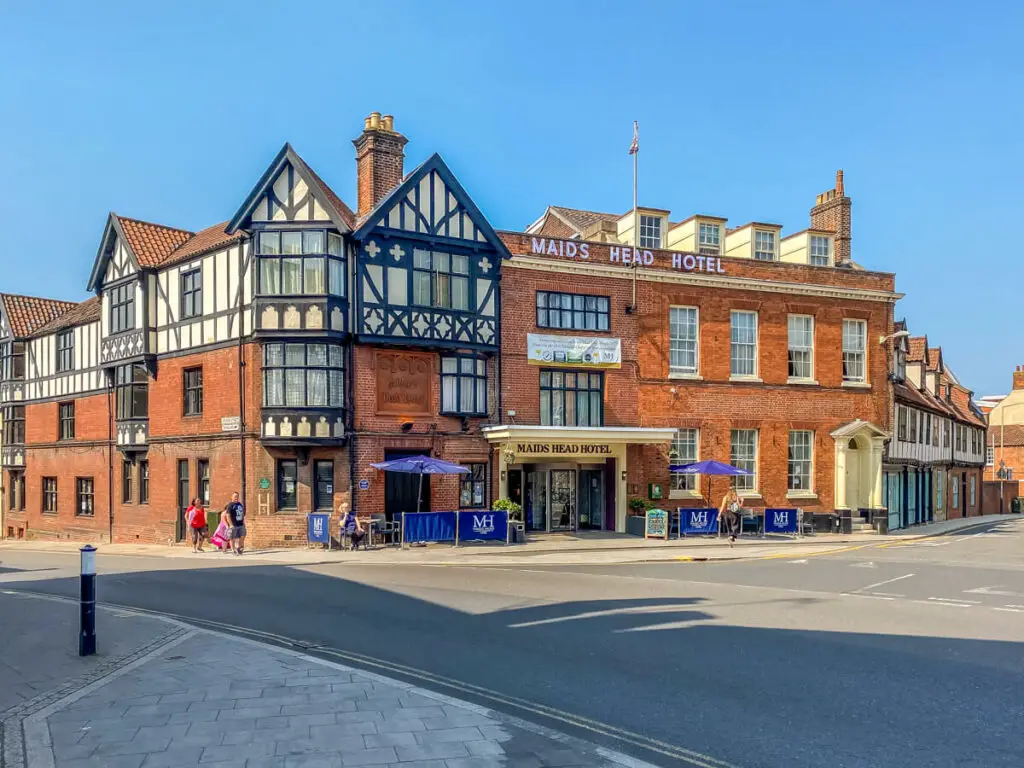
The Maids Head Hotel is located on the site where the first Norman Bishop of Norwich, Herbert de Losinga had his original palace. The site has been continuously used for hospitality since about 1090, so the hotel claims to be the oldest in the UK.
The oldest parts of the Grade II listing building you see today date from the 15th century. The bar and snug are slightly ‘younger’, as they were added in the late 16th century.
The hotel is also reportedly one of the most haunted places in Norwich. If you would like to stay at Norwich’s most haunted hotel, you can check prices and availability here. Read Tripadvisor reviews here.
RELATED: Maids Head Hotel Afternoon Tea Review
#14 Norwich Castle has the largest collection of British ceramic teapots in the country
The 3,000 teapots were given to the museum by two collectors – Edward Bulwer and Philip Miller. The collection helps tell the 300-year story of a nice cup of tea, tea parties, and the tea trade.
There are some pieces from the porcelain factory in Lowestoft which was the only one in East Anglia. One miniature tea set from the 18th-century might have been a sample for a salesman or a child’s toy.
#15 There is a fossilised keyboard in Norwich.
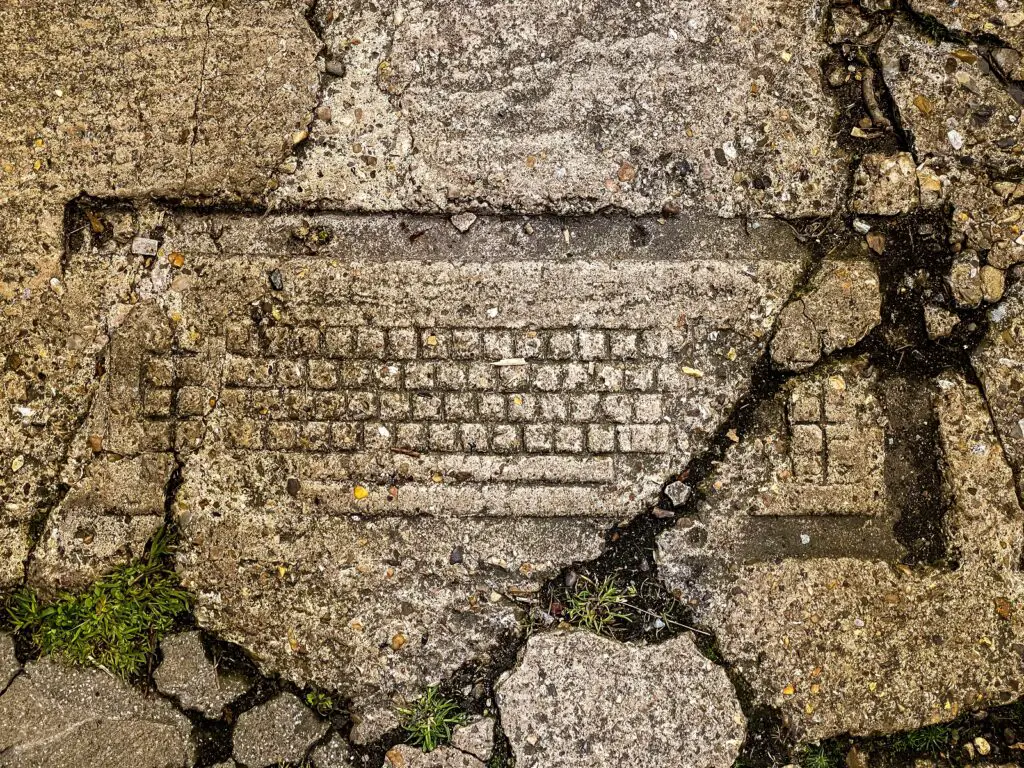
The fossilised keyboard was created as an art project in 1999 by Molly Sole who was a student at the Norwich School of Art and Design. It can be found at the corner of Princes Street and Elm Hill, two of the most beautiful streets in Norwich.
Fun Facts about Norwich
Did you learn anything new from our random Norwich facts?
Let us know about any obscure Norwich facts that we should include in our list. We will keep adding more as we discover more interesting tidbits about the city where we live.
If you love Norwich as much as we do, be sure to sign up for our email newsletter here to keep up to date with the latest happenings.
Disclosure: This post contains affiliate links. This means we will receive a small commission for some purchases made using links in our blog with no additional cost to you. Please be assured we would not promote any product unless we believe that our readers will also benefit. The commission does not influence the editorial content of this site.

